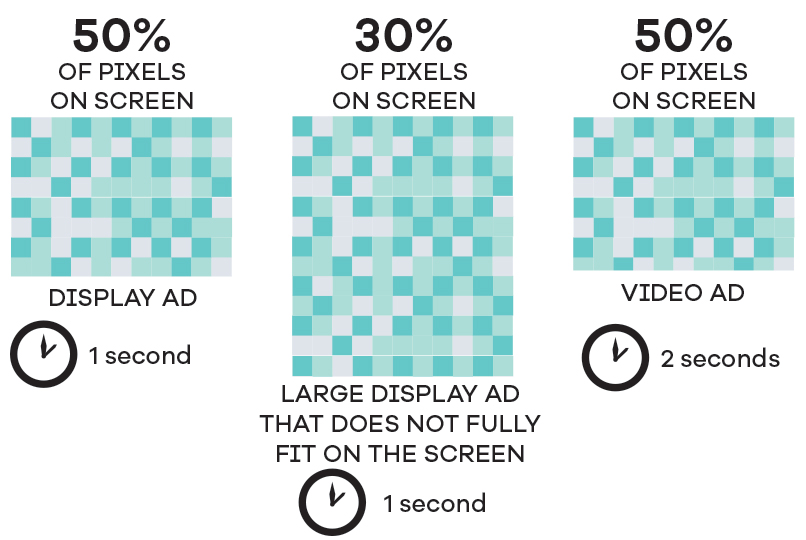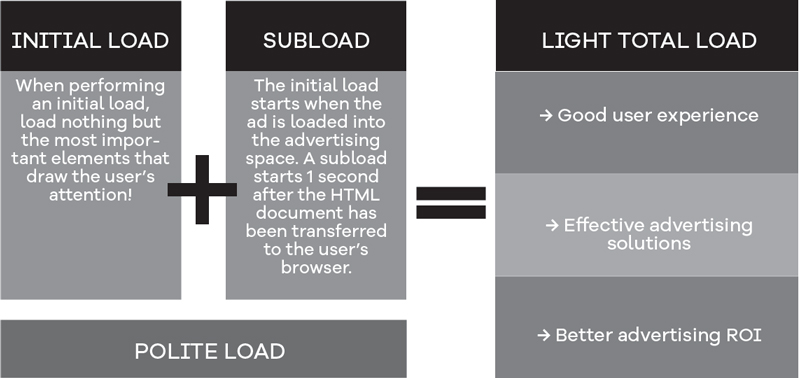The building blocks of functional advertising material
In reaching advertising goals, choices concerning the medium and concerning creative solutions play a significant role. It is also important to ensure that technical advertising functions operate in the best possible way.
The user experience that the advertisement creates for the consumer also impacts the campaign’s success. This experience should be considered when planning the technical implementation of the advertising materials.
Tips for technical optimisation of advertising material
- When loading the material, remember that its size is affected by images and by other elements, such as animations, scripts, fonts, calls, and more.
- Optimize and pay attention to the following features:
- The physical measurements and weight of the image in relation to the measurements of the advertising material
- For example, a 300 x 300 MPU does not need a 600 x 600 background
- The scripts and libraries. Only load necessary libraries that will be used. Some ads may load complete JavaScript libraries that are not even used in the ad. This adds unnecessary weight to the material and makes it load slower.
- The length of animations. The longer the animation, the heavier the material. Be critical about the value of the animation in conveying the ad’s message. For example, is it necessary that a car drives in and out of the ad, or would one stage be enough to create the desired impression?
- Check how many font files are really needed. Do not needlessly load bold and italic versions of the font if they are not used.
- Pay attention to how many calls the advertisement sends when fetching different elements.
- Images, texts, styles, tracking pixels, and fonts create more calls, which affects the load speed of the advertising material. Every call sent to an external server adds to the load time. The number of external calls should be minimized.
- The tracking pixels and tags are included in the total weight of the material. Most tracking systems make multiple calls and carry out various scripts during the tracking process. Therefore, it is good to consider to what extent the materials need to be measured.
- The physical measurements and weight of the image in relation to the measurements of the advertising material
- Always load the ad elements over a secure HTTPS protocol.
- Utilize a polite load to quickly offer the user something to see, even if some elements are still loading. The initial load should be as light as possible. The user will not wait for the ad to load, and an empty space creates a bad user experience.
- A good example of a tool for checking and optimizing the above elements is Developer Tools by Google Chrome.
Five tips:
- In reaching advertising goals it is important to ensure that technical advertising functions operate in the best possible way
- When loading the material, remember that its size is affected by images and by other elements
- Utilize a polite load to quickly offer the user something to see
- By optimizing the advertising’s technical material, the advertiser can improve the campaign’s functionality and the advertising’s viewability
- A well-built material is in a key position
More successful advertising through improved viewability
Ad viewability is a metric for tracking how many users have viewed an ad on a website, which helps to identify a sufficient number of ad impressions. By optimizing the advertising’s technical material, the advertiser can improve the campaign’s functionality and the advertising’s viewability.
The exact definition of viewability varies, and different systems measure it in different ways. Therefore, 100 % viewability is not possible, and operators in the industry define generally accepted standards for measuring viewability and for judging a good viewability rate.
The Interactive Advertising Bureau (IAB) defines viewability as:

IAB defines a good viewability rate as 70% for desktop ads and 50% for mobile ads.
Read more in the IAB Viewability guide (in Finnish).
The medium can influence the viewability of advertising spaces on its websites by, for example, considering the amount and the placement of advertising spaces and by using distribution technology. The advertiser, however, also has a significant role in improving the viewability rates of campaign material.
The advertiser can influence viewability rates by considering features such as:
- The weight of the material
- The weight of the initial load
- The amount of resources to be loaded
- The number of tracking pixels
- Creative advertising material
A well-built material is in a key position:
